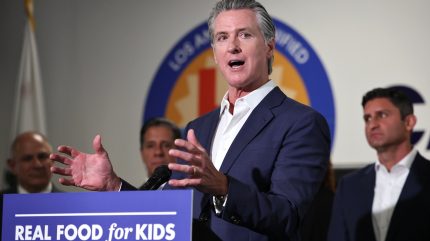
California has enacted a law to phase out the “most concerning” ultra-processed foods (UPFs) from school meals over the next decade.
The bill, signed by California Governor Gavin Newsom, will see the US state define UPFs “for school-related purposes”.

Discover B2B Marketing That Performs
Combine business intelligence and editorial excellence to reach engaged professionals across 36 leading media platforms.
In a statement, Newsom’s office said the “law is based on a simple, common-sense idea: schools should not serve students products that can harm their health or interfere with their ability to learn”.
The measure directs California health officials to issue regulations by 1 June 2028.
According to the bill text, the rules will define “ultra-processed foods of concern” and “restricted school foods”, taking into account factors such as whether ingredients or groups of ingredients are associated with health risks “based on reputable, peer‑reviewed, scientific evidence”.
Schools will be required to begin phasing out the restricted items and designated UPFs by 1 July 2029.

US Tariffs are shifting - will you react or anticipate?
Don’t let policy changes catch you off guard. Stay proactive with real-time data and expert analysis.
By GlobalDataFrom 1 July 2032, vendors will be barred from offering those products to schools.
A full prohibition on serving or selling meals and items containing restricted foods or specified UPFs will take effect on 1 July 2035.
Citing the federal Centers for Disease Control and Prevention (CDC), the governor’s office reported that in July, 32.7% of adolescents ages 12 to 19 had prediabetes.
The CDC and the National Institutes of Health have also underscored that nutritious diets help reduce the risk of heart disease, stroke, diabetes, and other chronic conditions, the statement added.
Newsom said: “We have been out front for years, removing harmful additives and improving school nutrition.
“This first-in-the-nation law builds on that work to make sure every California student has access to healthy, delicious meals that help them thrive.”
The move to limit UPFs – often packaged foods featuring added fats, starches, sugars, salt or hydrogenated oils – builds on broader public health actions in the state.
Three weeks ago, California’s legislature passed a bill to ban “forever chemicals” in food packaging and certain consumer goods.
In 2023, California approved a law banning four food chemicals already prohibited in the regions including the EU. More than 20 states have since adopted similar restrictions on those chemicals or on six synthetic food dyes in school meals.
At the federal level, in January the US Food and Drug Administration announced plans to prohibit the use of Red 3 (erythrosine, FD&C Red No. 3) in foods, dietary supplements and ingestible drugs.
The synthetic dye, used to produce a bright red colour in confectionery, baked goods, frozen desserts, icings and certain medications, must be removed from food products by 15 January 2027 and from drugs by 18 January 2028.
The FDA unveiled measures in April to phase out the use of petroleum-based food dyes by the end of next year.





